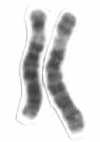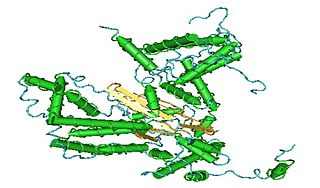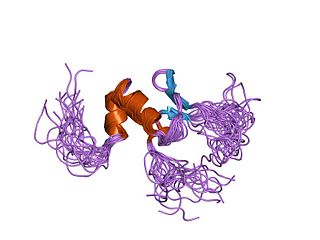
Pseudogenes are nonfunctional segments of DNA that resemble functional genes. Most arise as superfluous copies of functional genes, either directly by DNA duplication or indirectly by reverse transcription of an mRNA transcript. Pseudogenes are usually identified when genome sequence analysis finds gene-like sequences that lack regulatory sequences needed for transcription or translation, or whose coding sequences are obviously defective due to frameshifts or premature stop codons.

A gene family is a set of several similar genes, formed by duplication of a single original gene, and generally with similar biochemical functions. One such family are the genes for human hemoglobin subunits; the ten genes are in two clusters on different chromosomes, called the α-globin and β-globin loci. These two gene clusters are thought to have arisen as a result of a precursor gene being duplicated approximately 500 million years ago.
Transposase is an enzyme that binds to the end of a transposon and catalyses its movement to another part of the genome by a cut and paste mechanism or a replicative transposition mechanism. The word "transposase" was first coined by the individuals who cloned the enzyme required for transposition of the Tn3 transposon. The existence of transposons was postulated in the late 1940s by Barbara McClintock, who was studying the inheritance of maize, but the actual molecular basis for transposition was described by later groups. McClintock discovered that pieces of the chromosomes changed their position, jumping from one chromosome to another. The repositioning of these transposons allowed other genes for pigment to be expressed. Transposition in maize causes changes in color; however, in other organisms, such as bacteria, it can cause antibiotic resistance. Transposition is also important in creating genetic diversity within species and adaptability to changing living conditions. During the course of human evolution, as much as 40% of the human genome has moved around via methods such as transposition of transposons.
P elements are transposable elements that were discovered in Drosophila as the causative agents of genetic traits called hybrid dysgenesis. The transposon is responsible for the P trait of the P element and it is found only in wild flies. They are also found in many other eukaryotes.

Chromosome 1 is the designation for the largest human chromosome. Humans have two copies of chromosome 1, as they do with all of the autosomes, which are the non-sex chromosomes. Chromosome 1 spans about 249 million nucleotide base pairs, which are the basic units of information for DNA. It represents about 8% of the total DNA in human cells.

Chromosome 6 is one of the 23 pairs of chromosomes in humans. People normally have two copies of this chromosome. Chromosome 6 spans more than 170 million base pairs and represents between 5.5 and 6% of the total DNA in cells. It contains the Major Histocompatibility Complex, which contains over 100 genes related to the immune response, and plays a vital role in organ transplantation.

Chromosome 13 is one of the 23 pairs of chromosomes in humans. People normally have two copies of this chromosome. Chromosome 13 spans about 114 million base pairs and represents between 3.5 and 4% of the total DNA in cells.

Chromosome 17 is one of the 23 pairs of chromosomes in humans. People normally have two copies of this chromosome. Chromosome 17 spans more than 83 million base pairs and represents between 2.5 and 3% of the total DNA in cells.

Putative gonadotropin-releasing hormone II receptor is a protein that in humans is encoded by the GNRHR2 gene.

AT-rich interactive domain-containing protein 3B is a protein that in humans is encoded by the ARID3B gene.

Histone-lysine N-methyltransferase SETMAR is an enzyme that in humans is encoded by the SETMAR gene.

Keratin, type II cytoskeletal 78 is a protein that in humans is encoded by the KRT78 gene.

Chloride channel accessory 3, also known as CLCA3, is a protein which in humans is encoded by the CLCA3P pseudogene. The protein encoded by this gene is a chloride channel. According to the HGNC, this protein is not expressed in humans but is in certain other species such as mouse. However, some conflicting reports state that human cells produce and glycosylate this protein.

C7orf38 is a gene located on chromosome 7 in the human genome. The gene is expressed in nearly all tissue types at very low levels. Evolutionarily, it can be found throughout the kingdom animalia. While the function of the protein is not fully understood by the scientific community, bioinformatic tools have shown that the protein bares much similarity to zinc finger or transposase proteins. Many of its orthologs, paralogs, and neighboring genes have been shown to possess zinc finger domains. The protein contains a hAT dimerization domain nears its C-terminus. This domain is highly conserved in transposase enzymes.
A conserved non-coding sequence (CNS) is a DNA sequence of noncoding DNA that is evolutionarily conserved. These sequences are of interest for their potential to regulate gene production.
The Sleeping Beauty transposon system is a synthetic DNA transposon designed to introduce precisely defined DNA sequences into the chromosomes of vertebrate animals for the purposes of introducing new traits and to discover new genes and their functions. It is a Tc1/mariner-type system, with the transposase resurrected from multiple inactive fish sequences.

In molecular biology the BED-type zinc finger domain is a protein domain which was named after the Drosophila proteins BEAF and DREF, is found in one or more copies in cellular regulatory factors and transposases from plants, animals and fungi. The BED finger is an about 50 to 60 amino acid residues domain that contains a characteristic motif with two highly conserved aromatic positions, as well as a shared pattern of cysteines and histidines that is predicted to form a zinc finger. As diverse BED fingers are able to bind DNA, it has been suggested that DNA-binding is the general function of this domain. Some proteins known to contain a BED domain include animal, plant and fungi AC1 and Hobo-like transposases; Caenorhabditis elegans Dpy-20 protein, a predicted cuticular gene transcriptional regulator; Drosophila BEAF, thought to be involved in chromatin insulation; Drosophila DREF, a transcriptional regulator for S-phase genes; and tobacco 3AF1 and tomato E4/E8-BP1, light- and ethylene-regulated DNA binding proteins that contain two BED fingers. Most genes in this family are believed to have evolved from the hAT family of DNA transposons.

Inositol monophosphatase 3 also known as inositol monophosphatase domain-containing protein 1 (IMPAD1) is an enzyme that in humans is encoded by the IMPAD1 gene.

The flavin-containing monooxygenase (FMO) protein family specializes in the oxidation of xeno-substrates in order to facilitate the excretion of these compounds from living organisms. These enzymes can oxidize a wide array of heteroatoms, particularly soft nucleophiles, such as amines, sulfides, and phosphites. This reaction requires an oxygen, an NADPH cofactor, and an FAD prosthetic group. FMOs share several structural features, such as a NADPH binding domain, FAD binding domain, and a conserved arginine residue present in the active site. Recently, FMO enzymes have received a great deal of attention from the pharmaceutical industry both as a drug target for various diseases and as a means to metabolize pro-drug compounds into active pharmaceuticals. These monooxygenases are often misclassified because they share activity profiles similar to those of cytochrome P450 (CYP450), which is the major contributor to oxidative xenobiotic metabolism. However, a key difference between the two enzymes lies in how they proceed to oxidize their respective substrates; CYP enzymes make use of an oxygenated heme prosthetic group, while the FMO family utilizes FAD to oxidize its substrates.
Tc1/mariner is a class and superfamily of interspersed repeats DNA transposons. The elements of this class are found in all animals, including humans. They can also be found in protists and bacteria.













